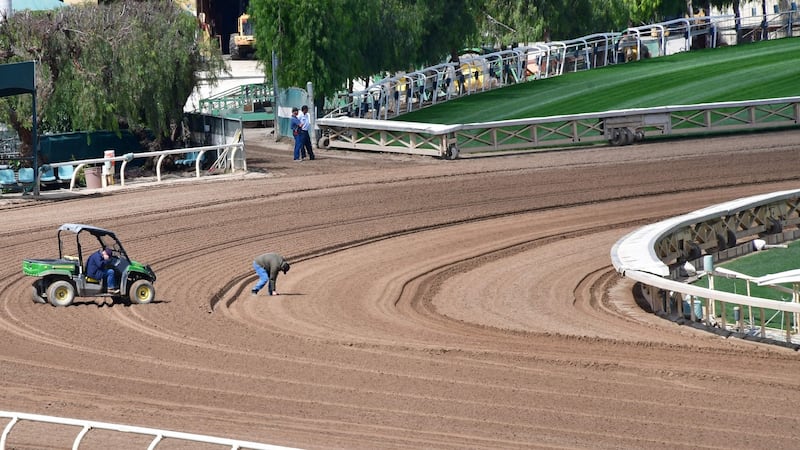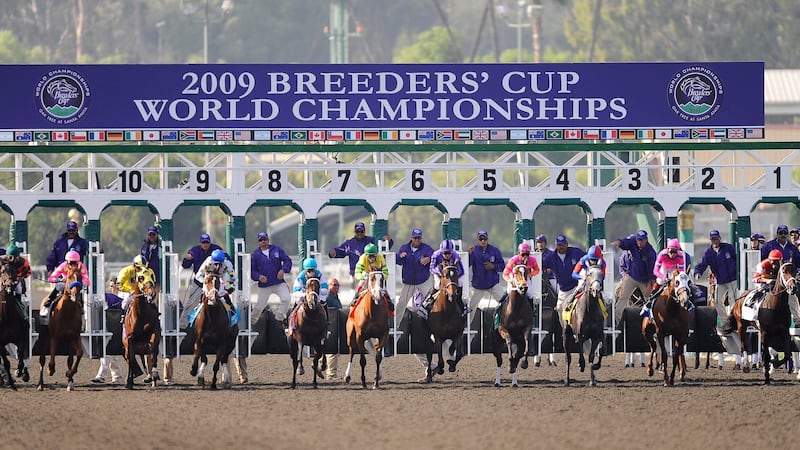Santa Anita, sitting in the shadow of southern California's San Gabriel mountains, has always been a special place for American racing fans. Horses like Seabiscuit, Affirmed and John Henry have won famous victories on its track while, during Hollywood's golden age, actors such as Errol Flynn, Marlene Dietrich and Bing Crosby would cheer on from the stands.
But late last Tuesday night, the racetrack announced it was closing immediately as it seeks to discover why so many horses have been killed there this winter. It will will open its one-mile main dirt track to limited training on Monday.
Since December 26th, when the current winter-spring meet began, 21 horses have died during racing or training at Santa Anita – a figure markedly higher than in comparable periods over the last three years.
The dirt track is blamed by many and is undergoing extensive testing. Meanwhile, some Santa Anita trainers have claimed that they have been pressured to run horses even when they are uncomfortable doing so. A New York Times article from Thursday says that in California, horses are worked out by their trainers more frequently than in other states.
In 85-90 per cent of all catastrophic injuries, there are pre-existing conditions at the site of the breakdown
But while the track has come under intense focus, so too has the entire industry's approach to racehorse welfare and safety. Particularly the ways it responds to the myriad factors that can weigh into any one catastrophic injury. For example, the California Horse Racing Board's equine medical director, Rick Arthur, frequently points out how, in 85-90 per cent of all catastrophic injuries, there are pre-existing conditions at the site of the breakdown.
In many ways, horse racing in the States has made progress over the past 10 to 15 years in better understanding these complicated factors. And yet fundamental problems clearly remain. One of those concerns the way horse racing uses, or fails to use, the wealth of fatality data it has accumulated over the years.
"We've got a good chunk of the data. We need to apply that, and process that, and then we need to find out where the gaps are," said the University of Kentucky's Mick Peterson, whose work with racetrack surfaces often overlaps with other areas related to racehorse injuries. "And there are other gaps."
The Jockey Club’s Equine Injury Database (EID) has been a useful tool in this regard. According to the database, between 2009 and 2017 (the 2018 numbers have yet to be released) race-day fatalities nationwide have been on a downward trend. One striking trend is that some surfaces appear safer than others. In 2017, there were 1.36 fatalities per 1,000 starts on turf tracks compared to 1.74 fatalities per 1,000 starts on the dirt. Synthetic surfaces cause fewer fatalities than both of those. In 2017, there were only 1.1 fatalities per 1,000 starts on synthetic tracks.
Why is this pertinent to Santa Anita? In 2010, the facility ripped out its synthetic surface after a three-year experiment with the material was beset with drainage and maintenance problems. It was replaced with a dirt track, in line with most racecourses throughout the US.
That said, a greater use of science in dirt track maintenance in recent years has improved the safety of these surfaces. A key point is racetrack consistency, which one recent study describes as being vital to the “performance and orthopaedic health of the horse”. And that consistency has been hard to maintain this winter, as heavy rains have hit Santa Anita, something Peterson believes could be a factor in the fatalities. “It’s unusual weather for the trainers to make their judgments, and it’s unusual weather for the track men to make their judgements. It’s unusual weather for everything,” he said.
Indeed, inclement weather and racetrack inconsistency were highlighted as possible causes for spikes in fatalities at two other tracks, Saratoga and Aqueduct, in recent years.


Through databases like the EID, the industry has been able to identify certain horses that are at higher risk of fatal injury, such as those that are returning to racing after a certain time on the sidelines, or older horses that didn’t race when younger. And that information can be vital. For example, the 2016 summer meet at Del Mar racetrack in southern California was beset with a high number of horse deaths. The following year, Del Mar instituted a variety of drastic changes, including a measure designed to identify and much more thoroughly evaluate at-risk horses before they ran. The last two summers, fatalities at the track have been markedly down. The kinds of steps that Del Mar took are far from broadly replicated nationwide, however.
But track surfaces and databases are only two parts of the equation, with medication also attracting attention. The National Uniform Medication Program was established over a decade ago to bring uniform drug rules and testing protocols throughout the nation’s racetracks. But only 12 of the 33 relevant racing jurisdictions have adopted the programme in full. The others are still adopting it piecemeal.
As for Santa Anita, there are still any number of unanswered questions
"We're down to only one state in thoroughbred racing that does not have an accredited lab. That's light years from where we were 10 years ago, when we started," said Dionne Benson, executive director of the Racetrack Medication and Testing Consortium. Nevertheless, "there would be very few in this industry, from the regulatory side and the national side, that would not like to see everyone adopting this," she said.
Frustrated with the continued lack of medication and regulatory uniformity among all jurisdictions, a number of high-profile individuals and organisations have thrown their weight behind a proposed Bill that would bring racing under a centralised governing body.
As for Santa Anita, there are still any number of unanswered questions. Every horse killed at the track has undergone, or will undergo, a necropsy examination, which will help explain if there were any underlying medical issues. Necropsies can take up to three months to complete.
“Santa Anita did the right thing,” said Peterson, about the track closing for an indefinite period. “It’s time to step back, take a breather, figure out what’s going on, because obviously there’s something here.” – Guardian










